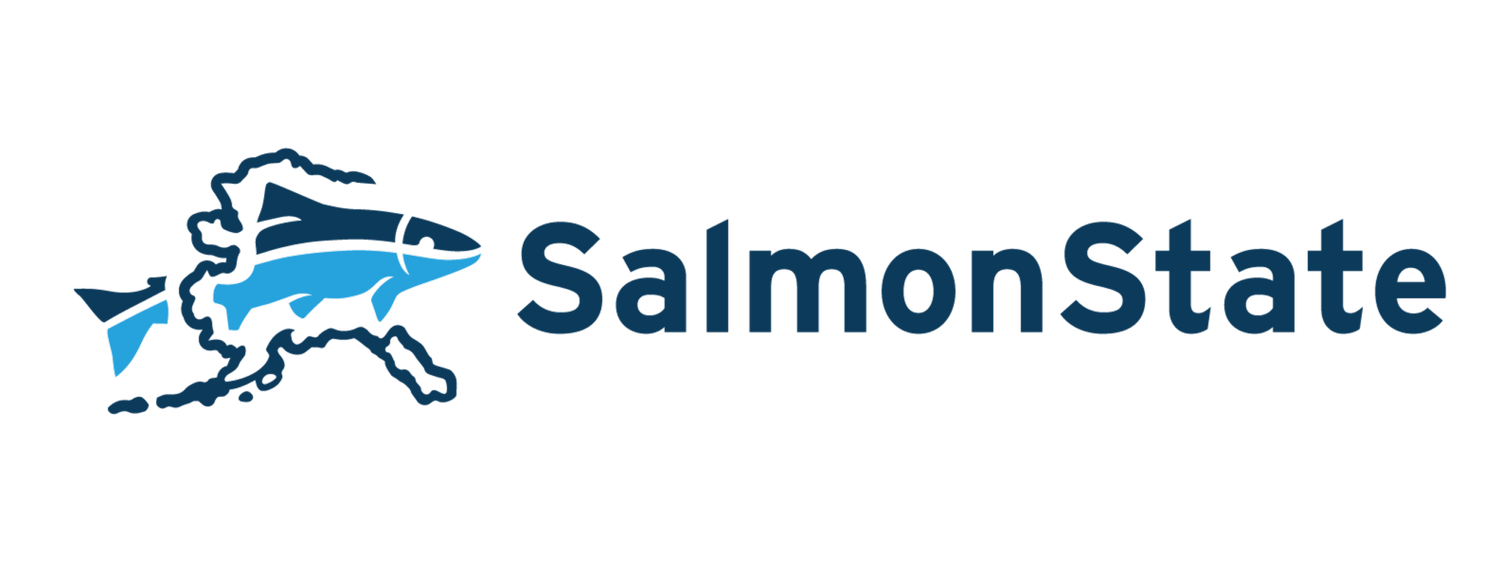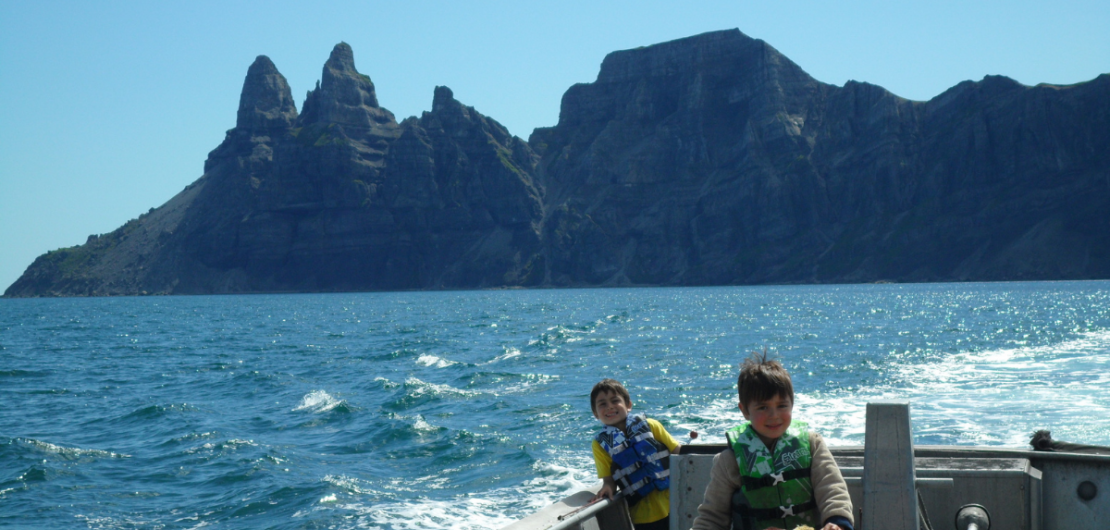A Tale of Two Salmon
Axel’s boys, Axel & Ronan, hanging out in the power skiff near Castle Cape. Courtesy of Axel Kopun
Bristol Bay’s sockeye run began breaking records in 2018. The same year, Chignik, which is on the other side of the Alaska Peninsula, failed to meet its minimum escapements for the first time in recent memory. Now, Chignik’s residents and fishermen are working to address and bring attention to these unprecedented declines, and to save their way of life.
Axel Kopun and George Anderson have fond memories of the Chignik purse seine fishery’s heyday. Once, Kopun was on a boat hauling in a purse seine so full of sockeye salmon that the corks holding the net up started to sink. Fish were jumping out of it. And one of the crew members jumped right into the net seething with salmon to hold up the corks and keep fish in.
A catch of red salmon headed for the cannery, Chignik, 1940. Alaska State Historical Collections. Leslie Melvin Collection of Alaskan Photographs.
In 2018, however, Chignik’s fishermen were left with no salmon in their nets or fish in their smokehouses.
Chignik has two genetically distinct runs of sockeye: one early, one late. That year, for the first time in Elders’ memory, both failed to meet their minimum escapement goals. Local salmon fishermen, both commercial and subsistence, were unable to fish. People in the five villages that make up “the Chigniks” scrambled to respond, creating the Chignik Intertribal Coalition.
“The formation of the coalition was to make sure people had food in their freezers to feed their family that first year,” said Anderson, who serves as coalition president. “In my lifetime, it was the first time when we did not meet minimum escapement or were able to go subsistence fishing. Everyone was really in shock. We didn’t know where to turn. With our food security destroyed, that gave us a pretty clear direction to stabilize food security for our families. It went beyond economic viability.”
Since 2018, every early run has failed, and multiple late runs as well. Commercial fisheries have opened only rarely. There have been federal subsistence closures for both sockeye and Chinook almost every year since 2018. In 2020, instead of harvesting salmon with his granddaughter, Anderson was driving to the airport with her, to help pick up Bristol Bay salmon donated by Northline Seafoods through the Alaska Sustainable Fisheries Trust’s Seafood Donation Program.
Though he and everyone else in Chignik was grateful for the donation, “a part of me was sad,” he said. “I thought it was ironic. Here I am, teaching my granddaughter how to pick up fish at the runway donated from another area, instead of how and where to catch salmon in our home area.”
Just as in the Arctic, Yukon and Kuskokwim regions, salmon failures impact much more than fishermen’s bottom lines.
“Salmon is pretty much everything,” Kopun said. “We eat it every way possible. My whole family. My friends, their families, my aunts, uncles, cousins – everybody in Chignik. You smoke it, salt it, dry it, freeze it for the winter, can it. Salmon puts food on the table, literally and figuratively. We eat them and we make money to buy all of the other stuff. Salmon puts a roof over our head.”
Axel Kopun, his sons, a couple cousins getting some subsistence fish with their gill net. Courtesy of Axel Kopun
Studies from the University of Washington’s Alaska Salmon Program, which has been studying salmon in Bristol Bay and Chignik for more than 70 years, show that “freshwater habitat in the Chignik watershed has become progressively more productive for juvenile sockeye salmon over the last 60 years, and has been consistently above average since 2005,” according to 2019 testimony from Dr. Daniel Schindler, a professor with the University of Washington’s School of Aquatic and Fishery Sciences to the Alaska Board of Fish after the 2018 Chignik fishery disaster. The testimony continued, “As can be seen for sampling in both Chignik and Black lakes, juvenile sockeye were substantially larger than average in 2014, demonstrating they had experienced above average growth conditions during their freshwater nursery period… overall, our long-term data show that growth conditions during the last 10 years have generally been better than the long-term average observed since 1961.”
In a March 8 presentation to ADF&G’s Chignik Advisory Committee, Alaska Department of Fish & Game scientists presented on studies which show a possible link between colder than average waters in Chignik, low zooplankton levels, higher numbers of competition for food, and less healthy juvenile salmon in the years salmon returning in years with poor runs would have been growing. But they also made clear that the reason for Chignik’s salmon decline is complex. “No one is saying all the problems are in the freshwater environment, or that they are all in the marine environment,” said ADF&G fishery biologist Kevin Schaberg.
Chignik residents and fishermen say they have a fair idea of one of the marine causes — as reflected in the Advisory Committee unanimously passing a resolution soon to be considered by the Board of Fish, which all five Chignik villages also support.
“Chignik-bound salmon have to pass through other fishing areas before making it back to the Chignik watershed where they spawn. If too many of those salmon are caught before they make it back to Chignik, then the conservation burden falls solely on us,” Kopun said. “We’ve had subsistence closures for both sockeye and Chinook in our watershed and even the upper part of Chignik Lagoon almost every year since 2018. Yet the interception fishery in Area M has continued, basically unchanged, the whole time. That’s unacceptable and that’s why we’re supporting Proposal 282 at the Board of Fish.”
Chignik Lake. Chignik Lake is the first of two lakes in the Chignik River system; it is longer and deeper than the second lake, Black Lake, which is wide and shallow. Image courtesy of the U.S. Fish & Wildlife Service.
Genetic studies have shown that fish caught by those fisheries can contain high levels of fish bound for Chignik. So the proposal, from Chignik Lagoon resident Don Bumpus, would cut the fishing time in the Shumagin Islands and Dolgoi Islands areas in June and July, until ADF&G is sure that 400,000 fish — the mid-range of targeted escapement for Chignik’s early run — will make it up the Chignik River by July 31, or until Chignik opens for commercial fishing. If escapement isn’t met, Chignik fishermen wouldn’t be fishing, either.
Kopun, who started fishing at age four and whose grandfather started fishing in Chignik in 1936, would like to pass on his way of life to his children. But he’s not sure he’ll be able to.
“We’ve got a pretty long history – but it might all be history pretty soon the way things are going,” he said. “All those things come together and it’s been the perfect storm of dismantling our communities and our fishery. All we are asking for is our escapement. All we want is for our local salmon runs to be sustainable. Right now they are not.”




